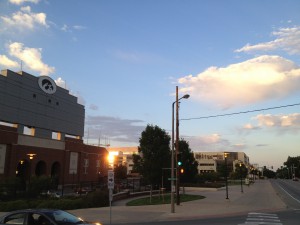 As a photographer, I’m probably more aware of light because it’s largely what determines the quality and character of a photograph.
As a photographer, I’m probably more aware of light because it’s largely what determines the quality and character of a photograph.
Yesterday, on my evening bicycle ride home, I noticed some very bright warm evening light coming from the east. I like evening light because it can illuminate in a way that you don’t get during the day. I looked to find the source of the light and it was the UIHC (University of Iowa Hospitals and Clinics) in the distance. The light was so intense, it was like looking directly into the setting sun. It was like having a second sun in the sky.
I looked to the west where the sun was setting, but I couldn’t see it because of the trees. The photo above is a glimpse looking east from the Melrose Avenue railroad overpass.
This brief experience was a reminder to me of the benefits gained when reflective materials are used in architectural design of buildings. There’s typically a net gain of ambient light, and opportunities to extend the available light beyond the time when the sun would normally be obscured.
Taller buildings selectively placed in urban areas can help capture light and reflect it down to the street level. Of course, too many high rise buildings in an area can reduce or eliminate this benefit because each building needs a line of sight to the horizon free of obstructions.
A perfect example of a project that should result in a net gain of ambient light is the upcoming Moen Group project in the downtown Iowa City area.
A short and traditional building would not increase the ambient light. However, a taller building of 14 or more stories (like the one proposed by the Moen Group) should increase the available light.
Presently, trees and other buildings create shade in the downtown pedestrian mall. So, regardless of how much light exists, the current conditions block much of it. Once the sun goes beyond the Jefferson Building and other buildings on the west side of the pedestrian mall, the area is void of direct sunlight.
However, the new building proposed by the Moen Group should at least allow a few more rays of reflected light to make it to the street level.
The building proposed by the Moen Group is 14 stories, making it slightly taller than the Jefferson Building. This is essential so it can reflect the light of the sun that is currently obscured by the Jefferson Building and other buildings on the west side of the pedestrian mall.
In the winter, when the sun is visually further down on the southern skyline as we see it crossing the sky, there may be a shadow cast from the building, but from about noon onward it will fall on roof-tops north and north east of the proposed building. In the summer, from noon on, the sun will be beyond the building. The only time the building might cast a shadow on the Pedestrian Mall would be in the morning hours, but there are already buildings blocking the sun. The added shade will be negligible, and the additional reflected light more than makes up for it.
In addition to bringing light to the downtown area, the building should also create a net profit to the city from the additional tax revenue and other benefits. [source] Because of the many benefits delivered back to the city (at the developer’s expense), the city is considering a 2.5 million dollar investment in the project as well (to be recovered through taxes over about 10 years). These funds would be provided using a TIF. This is an equitable way to compensate businesses and developers for delivering added value to an area.
Please support the Moen Group’s new project in any way you can.
